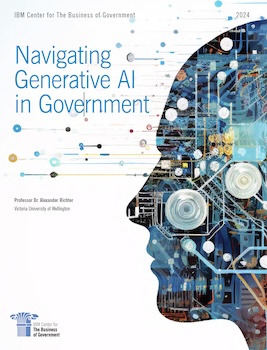
Navigating Generative AI in Government

On behalf of the IBM Center for The Business of Government, we are pleased to release this new report: Navigating Generative AI in Government by Professor Dr. Alexander Richter, Wellington School of Business and Government, Victoria University of Wellington.
Generative AI refers to algorithms that can create realistic content such as images, text, music, and videos by learning from existing data patterns. Generative AI does more than just create content, it also serves as a user-friendly interface for other AI tools, making complex results easy to understand and use. Generative AI transforms analysis and prediction results into personalized formats, improving explainability by converting complicated data into understandable content. As Generative AI evolves, it plays an active role in collaborative processes, functioning as a vital collaborator by offering strengths that complement human abilities.
Check out our infographic on the report!
Generative AI has the potential to revolutionize government agencies by enhancing efficiency, improving decision making, and delivering better services to citizens, while maintaining agility and scalability. However, in order to implement generative AI solutions effectively, government agencies must address key questions—such as what problems AI can solve, data governance frameworks, and scaling strategies, to ensure a thoughtful and effective AI strategy. By exploring generic use cases, agencies can better understand the transformative potential of generative AI and align it with their unique needs and ethical considerations.
This report, which distills perspectives from two expert roundtables of leaders in Australia, presents 11 strategic pathways for integrating generative AI in government. The strategies include ensuring coherent and ethical AI implementation, developing adaptive AI governance models, investing in a robust data infrastructure, and providing comprehensive training for employees. Encouraging innovation and prioritizing public engagement and transparency are also essential to harnessing the full potential of AI.
We hope that this report provides government leaders and stakeholders with a practical set of considerations and potential actions that enable them to capture benefits and minimize risks from generative AI.



